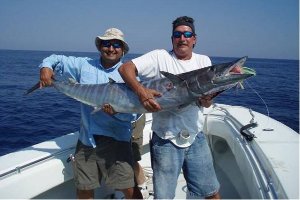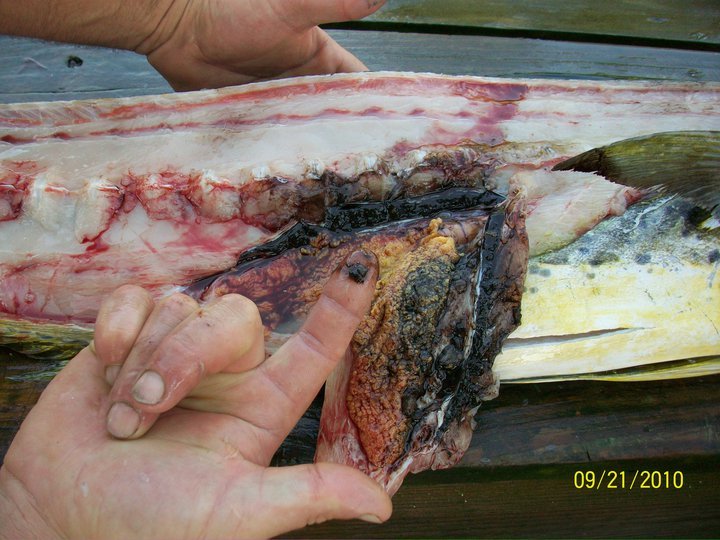Reappearance of Huge Plumes of Oil is Making It Hard to Pretend that the Problem Has Disappeared
Florida Oil Spill Law -&- Washington’s Blog


“I just got this from a friend fisherman in Florida. It just shows that the oil did not disappear but is slowly getting into the food chain. BP and the media are covering this up. This is only the start of chain reaction in the food chain.
Would you eat this??????
Please send this picture to everyone who cares about gulf seafood.”
– Keith Woodward
Photos; Facebook, October 25, 2010
There is a flood of information coming out on the Gulf oil spill. Why? The reappearance of huge plumes of oil is making it hard to pretend that it has all gone away.
Here’s a round-up of some of the Gulf oil headlines from just the last 4 days:
- More Independent Scientists Report “Vast Volumes of Oil Present on Seafloor”; Independent Research AGAIN Directly Contradicts NOAA/Coast Guard Findings
- EXCLUSIVE PHOTOS: Confirmed Fish Kill on Grand Isle; “Overpowering Stench of Death and Decay” Coming From BP “Death Mounds”
- Coast Guard Claims That Miles-Long Expanse of Oil on Gulf Surface Is Algae; Boat Captain: “I’ve never seen algae that looked orange, that was sticky, smelled like oil and that stuck to the boat and had to be cleaned off with solvent”
- “They are dying” says registered nurse working in Florida – “I’m seeing people who have been chemically poisoned”
- Valdez Toxicologist: “People are dropping dead now” – “I’m dealing with three autopsy’s right now.”
- State officials admit: “Worried about FISHERY COLLAPSES, based on the collapse of the herring fishery” after the Exxon Valdez
- “I’m scared of what I’m finding” says chemist – Corexit combines with oil to generate new compounds, … “many are on the EPA’s danger list. This is an unprecedented environmental catastrophe.”
- Fishermen Report Louisiana Bays Filled With Oil
- NEW TEST RESULTS: 8 out of 8 Blood Samples from BP Clean-up Workers Test Positive For Toxic Chemicals Found in BP Oil
- Chemist: Women more at risk – “Bleeding from their vagina and anus. Small kids are bleeding from their ears. This stuff is busting red blood cells”
- Feds Are Allowing BP to Leave Oil on Gulf Beaches
- Submerged oil surfaces: Fishermen say 10 MILE patch of brown foam “5 INCHES THICK with red swirls of oil”
- “They are literally shrimping in oil” says eyewitness – “It’s criminal that officials keep waters open”
- Catfish in lagoon “suffering burns across their heads and bodies” (VIDEO)
- Researchers discover oil plume drifting 300 miles from Macondo well (VIDEO)
- “May spark a whole new debate”: Scientist “astonished” that he found so much crude – Questions whether NOAA “dramatically understated” amount of oil in Gulf (VIDEO)
- “It’s Raining Bacteria”: Rain can spread flesh-eating microbes via “bio-aerosols” – “Also led to skin allergies and rashes”
- British Parliament report says Corexit 9500A “among the MOST CYTOTOXIC dispersants studied” – Major concerns by lead scientists: “we have fishing boats and cleaning crews working almost side by side”
- Federal Government Intimidates More Independent Researchers
- 46% of BP Oil Spill wildlife cleanup workers reported RASHES, itchy skin, or red skin – 35% with headaches
- COREXIT appears to STILL be inside blue crab larvae says Tulane researchers in Gulf
- Engineer confirms: “Toxic Corexit 9500A in MS Sound” after well capped
- Pensacola Bay, Fort McRae, has extreme toxicity levels – “the numbers are frightening” the toxicity levels are sky-high
- Researchers find “VAST VOLUMES” of oil on seafloor – Includes “Thick Raw Crude”
- Scientists find “long plumes” of oxygen-depleted water “emanating” from BP’s Macondo well site
- Fishermen sprayed while sleeping in group of 20 boats tied together – Now under doctors’ care (VIDEO)
- Oil Spill Commission Co-Chair Startled By Federal Rig Inspectors’ Lack of Formal Training and Lack of Knowledge of Underwater Drilling Operations
- “ We have dolphins that are hemorrhaging. People who work near it are hemorrhaging internally.” — BP dispersants are causing sickness (this is published by Al Jazeera, but is written by award-winning American reporter Dahr Jamail and quotes American scientists)
- Chemist: Chemicals from dispersed oil “coming down as rain”
- Oil + Corexit could linger for 300 YEARS says state official
- U.S. Government press release says NOAA, FDA now testing for dispersant Corexit – “We were astonished there were levels like that”
Clean up workers say that BP is limiting how much oil cleanup workers can clean up, and instead just covering oil up with sand, and that Corexit is still being sprayed at night.
“When I was about 10 yards from a peculiar but recognizable mound of sand, I started hearing the unmistakable buzz of flies. What I found was truly indescribable visually, I had never seen so many flies and the smell nearly brought me to my knees. There were at least 40-60 large redfish, drum and who knows what else under a BP death mound of sand in the exact same spot that I found the decapitated dolphin and bull redfish in May. There was also another mound about 20 yards away closer to the beach at Lat 29.199 N Long 90.047 W. The media continues to disregard or overlook these occurrences consistently, reporting that everything is OK, which I find hard to believe after finding this 6 months after the BP Spill”
Grand Island:
“The east end of the island behind State Park, which is still closed to the public. I couldn’t get to the beach, but there was heavy machinery, and the constant overpowering death stench coming from the other side of the levee.”
Frontline and ProPublica released a new documentary called The Spill which says:
- BP has a terrible track record of safety
- Workers had “an exception degree of fear” and worried about dying at BP’s texas oil refinery, and BP’s own plant manager pleaded for safety measures to be implemented. Headquarters said no.
- BP’s giant Alaska facility was only designed to last until 1987, and then was supposed to be torn down. But instead, according to one of BP’s Alaska workers: “They’re going to run everything to failure”.
- BP’s philosophy is: “How many lives can we afford to lose before we have to deal with this?”
- BP stopped doing a basic oil pipeline safety measure, which caused a huge spill in Alaska
- BP used too few inspectors, and used unqualified inspectors
- The giant Thunderhorse platform fell over because a key part was installed backwards
- Internal documents show BP engineers trying to find ways to cut costs and cut corners, so BP bypassed numerous normal safety measures.
- When Tony Hayward took over as CEO, he said he was going to increase safety … at the same time he insisted on substantial new cost cutting measures.
- Because BP is not being reined in or restricted, and still has a cost-cutting culture, giant, future accidents will occur.
But as Greg Palast notes , The Spill is a whitewash sponsored by Chevron, rehashing information which Palast and others reported on years ago, and falsely implying that other oil companies have stellar safety records.
Despite press release hoo-hahs that this Frontline investigation would break news from a deep-digging inquiry, what we got was “Investigation by Google,” old stuff from old papers that PBS forgot to report the first time around. … What us viewers were handed was a tale that could have been written by the PR department at BP’s competitor Chevron. The entire hour told us again and again and again, the problem was one company, BP, and its “management culture.” (They used the phrase management ‘culture’ seven times – I counted.)
… Unlike Shell Oil’s culture which has turned Nigeria into a toxic cesspool; unlike ExxonMobil’s culture which remains in denial about the horror it heaped on Alaska (Following the Exxon Valdez disaster, Corexit 9527 was associated with severe health problems suffered by thousands of clean up workers). And unlike Chevron’s culture, which I witnessed in the Amazon. Chevron culture left Ecuadoran farmers with pustules all over their bodies and a graveyard of children dead of leukemia.
If you want to know the point of the PBS show, just go to the network’s Newshour webpage where Chevron’s logo has sat atop the news as PBS’ top corporate sponsor.
The PBS “investigative” report lovingly features the statements of Shell, Conoco-Phillips, ExxonMobil and Chevron that, “BP did not act to industry standards.” Really?!!






 contact Obama!
contact Obama!